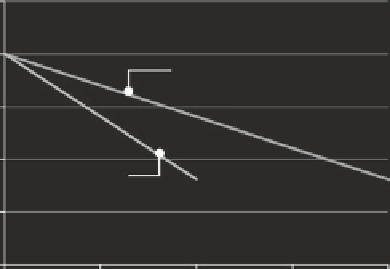Civil Engineering Reference
In-Depth Information
Fig. 5.2
Current density
decrease during an EA
forging test. Since the cross-
sectional area increases in
compression, the current
density will decrease over the
duration of the test
25
20
12.7 mm/min
15
10
25.4 mm/min
5
0
0
5
10
15
20
Time (s)
5.1.6 Strain and Temperature Effect on Resistance and
Current
By virtue of strain and material heating, the resistance of the sample, and ulti-
mately the induced current, is affected. Referring to Fig.
5.1
, the DC source is a
voltage source; the current is set through adjustment of the voltage and a variable
resistor as shown. During deformation, the resistance is affected by the workpiece
geometry and the material resistivity according to Eq. (
5.14
).
R
[]
=
ρ
L
A
.
(5.14)
For Al6061-T6, the resistivity (
r
) is given by Eq. (
5.15
):
r
=
4
×
10
−
8
(
1
+
0.0039
T
)
[
m
].
(5.15)
For specimens at different nominal applied current densities, the reduction in
resistance of the specimens is plotted in Fig.
5.3
. We observe that the geometric
effects dominate and that the specimen resistance decreases up to 87 % in the test
data. However, the overall system resistance is dominated by the variable resistor,
so this effect is negligible.
5.1.7 Analytical Model for Electrically Assisted Compression
The proposed thermo-mechanical analytical model is based on the stress-strain
equations presented for the classical test, but adapted to take into consideration
the various effects of the electrical energy on the deformation mechanism. Thus,
Eq. (
5.16
) represents the amount of electrical energy contributing to the deforma-
tion, as presented in Eqs. (
5.7
) and (
5.8
), and introduced in Eqs. (
5.3
)-(
5.6
).

